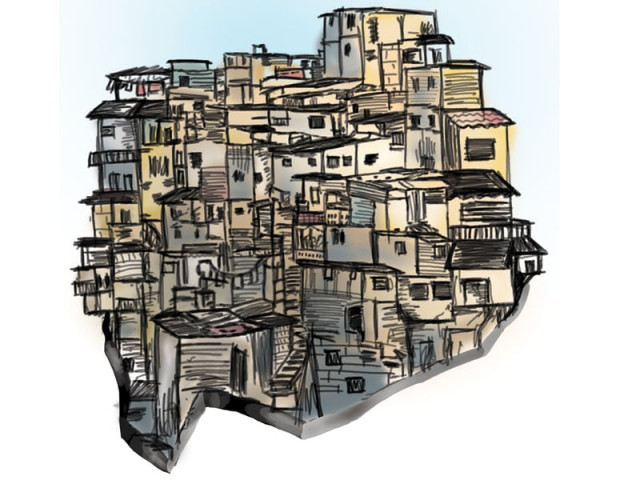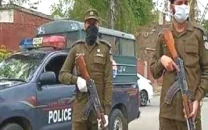The walled slums : Through the looking glass into Peshawar’s belly
An estimated 60%–70% of the provincial capital is made up of illegal settlements.

An estimated 60%–70% of the provincial capital is made up of illegal settlements. DESIGN: MUNIRA ABBAS
It is said behind every beautiful face is a story. The same is true for the provincial capital or, as it was known in the halcyon days, the city of flowers.
Peshawar, which was once known for its clean air, greenery and quiet roads, has now turned into another disfigured urban sprawl.
As the semi-organic expansion continues, one really has to struggle to find glimpses of the old city. Some reasons behind the rural-to-urban migration are routine – more jobs and better education. Others are more pressing – displacement due to militancy and military operations. Regardless of the cause, more and more vehicles spill into the streets daily. And the city’s resources and support systems are caving in under the pressure.

While there are no detailed studies on Peshawar’s informal settlements, an estimated 60%–70% of the provincial capital is made up of slums.
Nowhere to go but up
Squatter settlements which previously were temporary structures made of mud and other dismantle-able material are now concrete and cement houses. As evidenced by the lack of action, the settlers have learnt the district administration will announce ‘stern measures’ but never take them.
And so these settlements keep swelling – an unchecked growth in various parts of the city, including Changarabad, Gulbahar, Ring Road, Nothia and Hayatabad.
The clean water that once flowed in streams and ravines now gives off a pungent smell as most of these makeshift-turned-permanent houses have become communities but without amenities.
Without any drainage, garbage disposal or any sort of sanitation apparatus, these parts of the city are sinking in squalor, home to a host of diseases.
“Housing has become a never-ending problem for the urban poor and middle class. With a monthly income of Rs20,000 to Rs30,000, who can afford a flat or a plot of land?” stated Ahmad Ali, a student of University of Peshawar who lives on Supply Road, adjacent Changarabad.
With no affordable housing schemes, these slums are ripe for the land mafia to reap. Said to be hand in glove with the police, the mafia occupies the land and sells it to the highest bidder among those who have no other place to live.
According to Muhammad Khan, an auto-technician and a resident of Board Bazaar, land-grabbing has now grown into an organised business. And the residents are trying to get ahead of the game by establishing cause for land rights.
Getting out the vote
“Residents of these areas exercise their right to vote in the hope of getting ownership rights of the place where they have been living since long,” said Zahid Iqbal who lives in a slum in Nothia.
Most people living in these areas are registered voters, he shared.
“We have been living here for the past decade but the government is still reluctant to award us ownership rights,” said Salamat Shah, who lives in a slum in Changarabad with his six children. “Politicians gave us hope during the elections but never turned up afterwards,” he added.
For the slum dwellers, summer brings with it the septic floods of the monsoon season. These settlements turn into murky pools of dirty water mixed with overflowing sewage. With no place to go, the water stagnates, swells with insects that lead to more diseases like dengue, malaria and typhoid.
“It is hard to live here with leaky roofs and no gas. Once the mud wall of my hut caved in during the rain but fortunately my family was unhurt,” said Shah. “Looking for another place to live is not an option.”
Catch-22
While denizens of these damp environs have been declared illegal residents, the dwellers in turn question why authorities allowed them to build slums in the first place.
“People who live in these slums are from different walks of life, including skilled and unskilled labourers, industrial workers, workshop employees, and domestic and sanitary workers,” shared an official of the district administration.
“With a monthly income of Rs7,000 to Rs8,000 and six to seven mouths to feed, most of their money is spent on food and essentials.”
When contacted, District Administrator Rasheed Ahmad Khan said a large population of the city lives in unplanned, informal settlements.
“These areas were not planned thus not given basic facilities such as sanitation, health, education and emergency services,” confirmed Rasheed.
“To remove the encroachments we will have to raze the entire city,” he explained how intertwined the old city and the new settlements are.
“The problem prevails due to the large number of Afghan refugees who have settled in and around the city over the past 20 years, coupled with the recently displaced populace.”
On a positive note, Rasheed shared community involvement has increased of late, especially regarding cleanliness. “We conduct fumigation in these areas from time to time to prevent spread of diseases.”
Published in The Express Tribune, May 7th, 2014.



















COMMENTS
Comments are moderated and generally will be posted if they are on-topic and not abusive.
For more information, please see our Comments FAQ